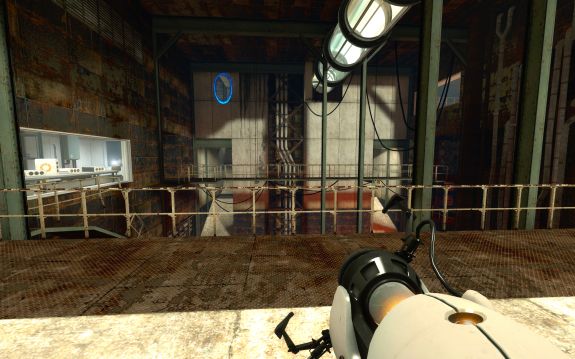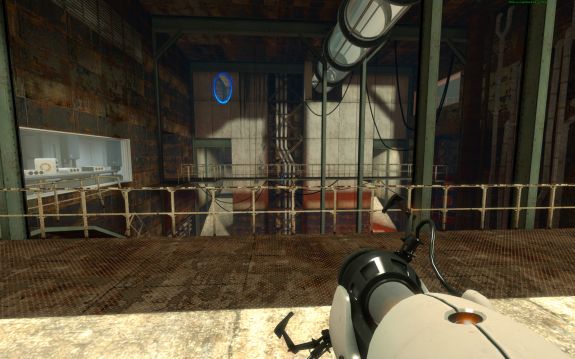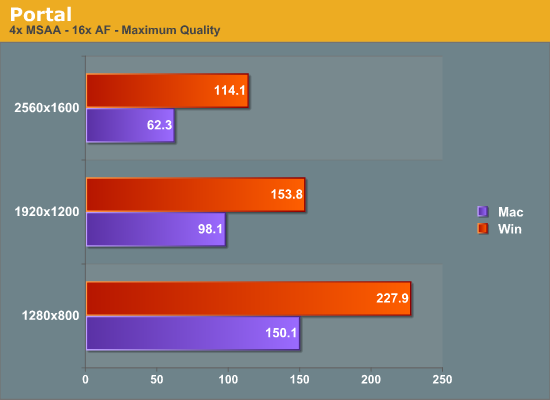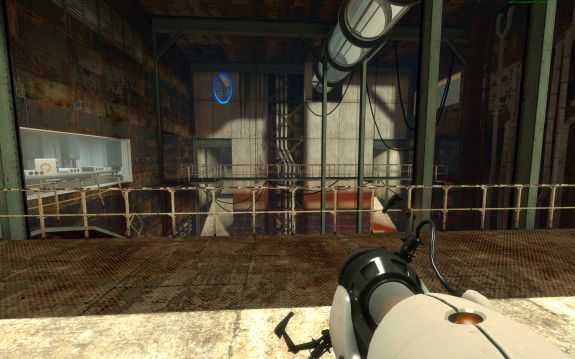Update 5/15/2010: Valve released a new patch for Portal on the 13th which resolved the blurriness issue. Please see our update below for for the full details.
It’s been a while since anyone treated Mac OS X as a first-tier gaming platform, so when Valve announced that they would be bringing their Steam service and the Source engine to the Mac, it was big news. After a roughly 2 month beta period for the Mac versions of Steam and the Source engine, yesterday Valve finally released the first wave of their Mac gaming efforts.
As it stands Valve is taking a gradual approach to rolling out their back catalog to the platform. Even though Steam is out and the Source engine has been ported, this week has seen the release of only 1 Source game for the Mac: 2007’s critically acclaimed Portal.
While it’s not the most graphically intensive Source game these days (that title belonging to Left 4 Dead), at this point it’s as good as anything else for looking at the performance of the Source engine under Mac OS X, particularly considering how long it’s been since a game’s original developer did the Mac port. So with that in mind, we went ahead and took a quick look at Portal’s performance under Mac OS X.
As is the case with all of the games on the Source engine, they’re designed to scale up and down fairly well. With modern hardware though, we’re hard-pressed to keep older Source games from achieving runaway frame rates. So Portal performance is somewhat arbitrary – most Macs with a discrete GPU should be able to handle it to an acceptable degree.
The Test
For our test we loaded up our GPU test rig with Mac OS X 10.6.3 in a Hackintosh configuration. As Mac OS X does not currently support either the GeForce GTX 400 series or the Radeon HD 5000 series, we had to step back a bit with our video card choice, settling for a GeForce GTX 285. And while the use of a Hackintosh does technically invalidate our results since it’s not a real Macintosh, based on our experiments we believe that our results don’t suffer in any way for using a Hackintosh, and as such we believe the results to be experimentally valid. But of course, your mileage may vary.
| CPU: | Intel Core i7-920 @ 3.33GHz |
| Motherboard: | Intel DX58SO (Intel X58) |
| Chipset Drivers: | Intel 9.1.1.1015 (Intel) |
| Hard Disk: | OCZ Summit (120GB) |
| Memory: | Patriot Viper DDR3-1333 3 x 2GB (7-7-7-20) |
| Video Cards: | NVIDIA GeForce GTX 285 |
| Video Drivers: | NVIDIA ForceWare 197.13 |
| OS: |
Windows 7 Ultimate 64-bit Mac OS X 10.6.3 "Snow Leopard" |
Image Quality
We’ll start quickly with a look at image quality. Valve is traditionally a staunch Microsoft ally, having built up their services and engines around Windows and DirectX. For the Mac OS X port of Source, Valve had to replace the DirectX backend of Source with Mac-appropriate components, the key of which is OpenGL. Such a change can impact image quality depending on how it’s done.

Portal - Windows. Click to enlarge

Portal - Mac OS X. Click to enlarge.
We have a gallery of screenshots, but for our analysis we’ll stick with comparing in a single set. Going with 2560x1600 with the game at its highest settings and 4xAA/16xAF, to our surprise the images are distinctly different when directly compared. The Mac screenshot is noticeably foggier than the Windows image, and textures appear to be less sharp. It’s not a night & day difference, but the Windows screenshot is distinctly clearer than the Mac screenshot. Without a Windows reference image it would be harder to tell that the Mac screenshot differs this much, but we believe that the difference is great enough that anyone with an eye for details that has ever played Portal on Windows would notice the foggier/blurrier IQ on the Mac.
Now some of this can be explained away due to gamma, since Mac OS X and Windows have different default gamma levels, but gamma could never explain the entire difference. There’s clearly a difference in IQ between the Windows and Mac OS X versions of Portal, and it’s not in the Mac’s favor. It’s by no means bad, but as one person put this when being shown these screenshots “It’s like looking at a magazine scan” when looking at the Mac.
Performance
The other half of our quick look is at performance. The Macintosh platform is renowned for being a graphical powerhouse, but this refers to professional/prosumer photography and the like. For gaming, Apple has been slow to include support for new hardware and new driver features (they are just now OpenGL 3.0 compliant) and overall their drivers are more conservative when it comes to performance. Portal is going to be slower, the question is by how much.

We went ahead and ran a timedemo from test chamber 18 and beyond on both the Mac OS X and Windows versions of Portal. We kept the settings cranked up at all times, but varied the resolution between 1280x800 and 2560x1600 to look at different GPU loads. At the worst-case of 2560, the Mac version of Portal runs at only 54% of the speed of the Windows version. That moves to 63% at 1920x1200, and 66% at 1280x800.
Portal – like all Source engine games – is CPU limited when given a powerful enough GPU, and even with just a GTX 285 we can approach that under Windows. Under Mac OS X however, we look to be GPU limited at all times. The framerate never suffers as we’re always averaging more than 60fps, but we can easily turn off MSAA and AF to improve performance if we needed to.
Closing Thoughts
For Source engine enthusaists hoping to see the Mac OS X port of the Source engine meet the high standards of the Windows version, Portal presents a mixed bag. In our limited testing the Mac version of Portal doesn’t significantly suffer for being a port, but at the same time it can’t quite match the image quality of the Windows version. Feature-for-feature there is parity, but the Mac version just isn’t as sharp as the Windows version.
Performance isn’t any better. Portal is an easy game to run and so we’re largely being academic here, but the “tax” for Mac OS X is roughly a generation in hardware performance. For the performance we’re seeing on a GTX 285 under Mac OS X the results are similar to what we’d see under Windows with something like a 9800GTX. Given that at the high-end the Mac platform is also a generation behind in hardware, and you’re looking at 2008 performance for Portal even with the best hardware you can get today for a Mac.
Ultimately having the Source engine ported to Mac OS X is going to remove the technical need to use Bootcamp to run Windows for games, but based on Portal it doesn’t remove the need to boot Windows for performance reasons. For long-time Mac users none of this should be surprising, but it means that we shouldn’t expect the Mac OS X version of the Source engine to be revolutionary.
Update: 5/15/2010
On Thursday after we published our article Valve pushed out an update for Portal that focused on fixes for the Mac version. The big fix was the following:
Fixed screen "fuzziness" caused by color correction operation
This fixed the blurriness issue we saw with the initial version of Portal. Texture and geometry quality is now as sharp as it is under Windows. Performance remains unchanged, while there is still an image quality difference between the two due to lighting differences and a general degree of fogginess that still appears on the Mac OS X version.























178 Comments
View All Comments
Makaveli - Thursday, May 13, 2010 - link
Bob 5 please put down the keyboard delete your account from this site and go back to your geek squad job.I second that is the dumbest comment I've heard this week on the internet.
I swear they should have ID scanners on these forums it should be 18+
qwertymac93 - Thursday, May 13, 2010 - link
Surprisingly(to me), I like the look of the mac screen shots better. I can clearly see the edges of geometry are being smoothed much better then on the pc. its kind of like going from 2x box aa to 6x wide tent...overall its blurrier but smoother at the same time. with the pc version, you can see were one object and another meet, there is a jagged edge(like they dont quite line up), the mac version looks like its one big piece. glass is also SEMI-transparent in the mac version, instead of completely transparent in the pc version.If i didn't know any better, id say the pc version isn't applying all the filters/effects it should be(at first, i got confused and thought the pc shots were the mac shots). the "jaggies" are so bad on the pc version, i have doubts its actually applying AA at all. i remember when i played mass effect and i forced AA, the frame rate would be cut dramatically and the jaggies were still there(accept on cutscenes/conversations, then it would be smooth). perhaps the same thing is happening with your portal shots. could you maybe take some screens of the pc and mac versions with AA/AF off completely, and compare them to the maxed out versions here? if the pc version is "cheating", it would help explain the massive performance difference. ati(4850?) testing would be nice too, but i know your busy.
the mac version looks more like the portal trailers, the ones with all the cool motion blur and more washed out colors. if you look at the bottom of the screens you featured, it looks like the "glow" from the concrete is going over the metal area too, while on the pc the bloom just stops right at the concrete, very unrealistic and i think the openGL version of the source engine is closer to the one they use for all their trailers and promos, I.E. tuned for quality and not speed.
asphix - Thursday, May 13, 2010 - link
Are you viewing the images at full resolution? I'm not seeing these jaggies in the PC version.. I do see edges which are more crisp and better contrast ratios.I am also baffled at your thought that the PC might not be applying some filters. Look at the glass on the left... in the PC there is a flare of light that is obviously missing on the mac. Also, right behind that there is some environmental lighting that is missing in the mac. Textures are night and day between mac and pc (pc being better).
I can understand you saying you like the mac better.. that's personal preference and completely understandable. However, your reasoning is flawed. If you like blurry images because you cant run it at a resolution that minimizes jaggies.. thats fine. If you prefer the gears of war style, everything is muted and dull.. that's fine too. But to say that the PC image is not rendering as accurate (the glass is transparent.. not frosted... there's lighting effects completely MISSING from the mac version) is just crazy.
bji - Thursday, May 13, 2010 - link
It's not crazy. He has a good point. I'm not going to say that one version is better than the other, they are just different. One place where the Mac version just looks better is along the top edge of the office window to the left. On the PC screen shot you can clearly see a jagged staircase pattern all the way across where the glass meets the metal. On the Mac version, it's very well smoothed.The rivet up the left side of the screen on the green metal are softer on the Mac too, noticeably so. I don't know which effect is better - the PC sharpness or the Mac softness - but I wouldn't say that one is definitely better than the other; that's just preference I guess.
I'm not trying to say that the Mac version is overall better or that the apparent lack of smoothing in many places in the PC image is the cause for its better performance; what I am trying to say is that it's much more complicated than you seem to want to believe, and that the original poster had some good points that ought not to be so readily dismissed.
t0njohn - Thursday, May 13, 2010 - link
A fix for "fuzziness" should be shipping in the near future.CptTripps - Thursday, May 13, 2010 - link
Mac lacks certain lighting elements which make it look bland and... that is not AA at work, the mac is just plain blurry.JarredWalton - Thursday, May 13, 2010 - link
Almost looks like the Mac version is applying SSAA on the whole scene as opposed to MSAA. It also looks like the Mac version is using console game textures in place of high res texturing. Seriously, that Mac image looks horrible to me.Ryan Smith - Thursday, May 13, 2010 - link
I actually had considered that, but the GTX 285 would never be able to do SSAA at 2560 like that. If it is doing SSAA for some reason, it's not the whole screen.beelsebob - Thursday, May 13, 2010 - link
You're testing on a machine with a graphics card that no mac has *ever* had in it. No mac has even ever had a graphics card from the same series. You're lucky the driver for this card even exists, and the fact that it's not very optimised at all really isn't a big surprise. I'd love to see you repeat this either with a GeForce 3 series, or radeon 4 series.Inkjammer - Thursday, May 13, 2010 - link
http://www.anandtech.com/show/2805Anandtech reviewed the GeForce 285 Mac edition. There were Mac editions of that card produced.